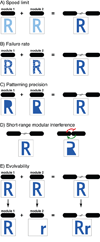Shadow enhancers: frequently asked questions about distributed cis-regulatory information and enhancer redundancy
- PMID: 22083793
- PMCID: PMC3517143
- DOI: 10.1002/bies.201100121
Shadow enhancers: frequently asked questions about distributed cis-regulatory information and enhancer redundancy
Abstract
This paper, in the form of a frequently asked questions page (FAQ), addresses outstanding questions about "shadow enhancers", quasi-redundant cis-regulatory elements, and their proposed roles in transcriptional control. Questions include: What exactly are shadow enhancers? How many genes have shadow/redundant/distributed enhancers? How redundant are these elements? What is the function of distributed enhancers? How modular are enhancers? Is it useful to study a single enhancer in isolation? In addition, a revised definition of "shadow enhancers" is proposed, and possible mechanisms of shadow enhancer function and evolution are discussed.
Copyright © 2012 WILEY Periodicals, Inc.
Figures


References
-
- Wray GA, Babbitt CC. Enhancing gene regulation. Science. 2008;321:1300–1301. - PubMed

